
Behavioral Apparatus Museum: Responses
Early Rat Lever Designed for Student Use
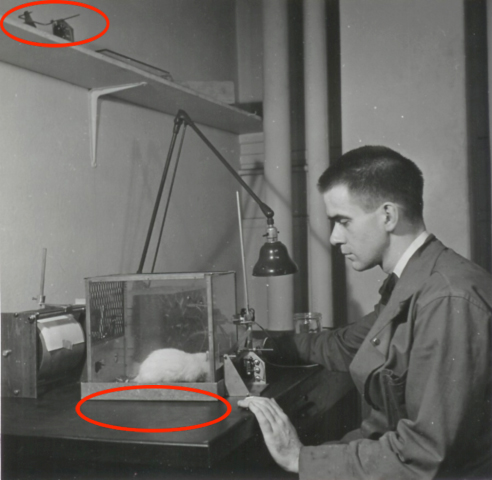
Examples of this rat lever are no longer to be found. It was used at Columbia University in the 1940s and 1950s in the rat lab portion of the introductory psychology course. Two such levers are shown in the photograph, shown inside the red ellipses. One is above the rat box on the shelf and the other is being responded on by the rat in the chamber. The student in the photograph is James Dinsmoor, who went on to a most distinguished career in the experimental analysis of behavior. Also visible in h photograph is a rat pellet dispenser and a student model cumulative recorder, both described in other rooms of this virtual museum.
Vertical Rat Operandum
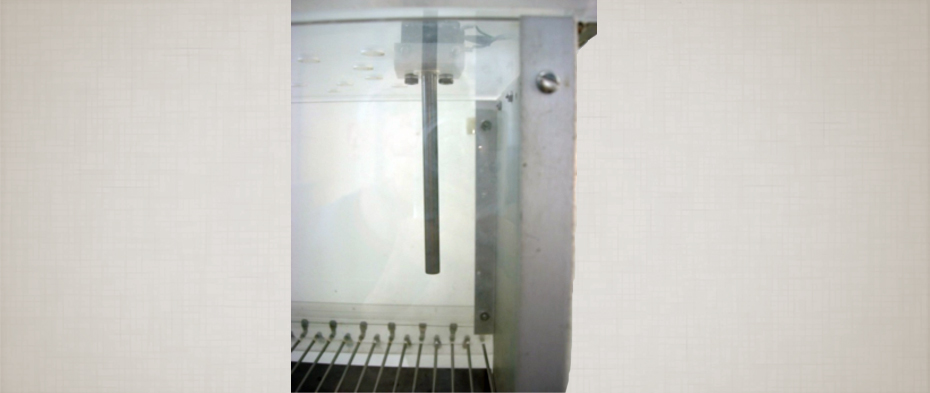 It sometimes is useful to study two topographically different responses at either the same or different times. This vertical rat operandum can be activated by pushing on it in any direction. Pushes of a sufficient distance activate a switch located at its top. The operandum is a stainless steel tube about 3/8 inch in diameter and 4 inches long.
It sometimes is useful to study two topographically different responses at either the same or different times. This vertical rat operandum can be activated by pushing on it in any direction. Pushes of a sufficient distance activate a switch located at its top. The operandum is a stainless steel tube about 3/8 inch in diameter and 4 inches long.
Ralph Gerbrands Company Standard Rat Lever
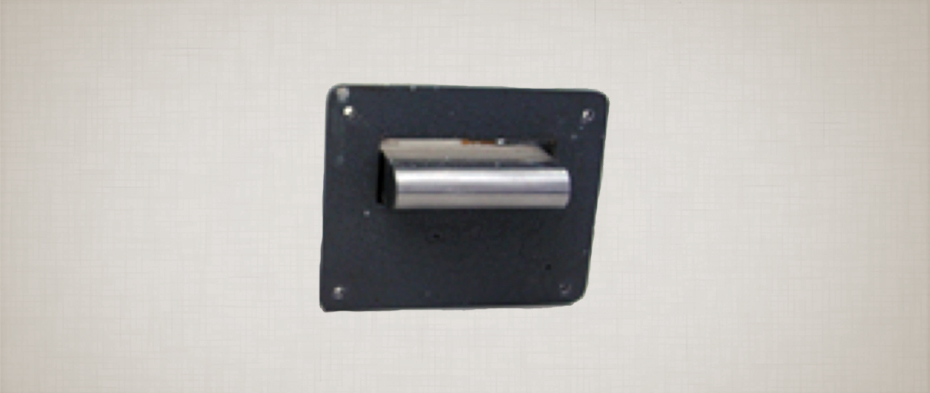 This durable rat lever is made of stainless steel and is about 3 inches wide by 1 inch wide by ½ inch high. It is attached to an electric switch in the rear (see the scientific Prototype Company rat lever also in this display) that operates when the lever is depressed below a prescribed level. The force required to operate the switch can be varied by adding more counterweight to the rear of the lever.
This durable rat lever is made of stainless steel and is about 3 inches wide by 1 inch wide by ½ inch high. It is attached to an electric switch in the rear (see the scientific Prototype Company rat lever also in this display) that operates when the lever is depressed below a prescribed level. The force required to operate the switch can be varied by adding more counterweight to the rear of the lever.
Lehigh Valley Rat Lever
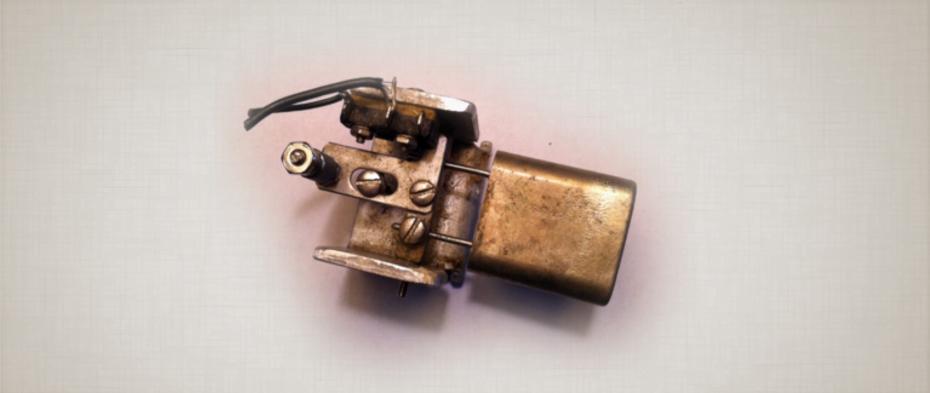 This smallish rat lever, shown in both top and side perspectives, including both assembly and lever is 2.5 inches (6.5 cm) long. The lever itself is 1 3/16 inches long (3 cm) long,1 inch wide (2.5 cm), and 3/8 inch thick (1 cm). The lever is hollow. Depressing it operates a small microswitch with two wires attached to it, particularly visible in the top view of the lever (top photo). The stacked screws at the rear of the lever serve to counterbalance the lever and also allow variation in the force required to operate it. This lever, manufactured by Lehigh Valley Electronics, was not as durable as, for example, the larger stainless steel levers manufactured by the Ralph Gerbrands Company. Rats tended to gnaw through these levers with repeated use.
This smallish rat lever, shown in both top and side perspectives, including both assembly and lever is 2.5 inches (6.5 cm) long. The lever itself is 1 3/16 inches long (3 cm) long,1 inch wide (2.5 cm), and 3/8 inch thick (1 cm). The lever is hollow. Depressing it operates a small microswitch with two wires attached to it, particularly visible in the top view of the lever (top photo). The stacked screws at the rear of the lever serve to counterbalance the lever and also allow variation in the force required to operate it. This lever, manufactured by Lehigh Valley Electronics, was not as durable as, for example, the larger stainless steel levers manufactured by the Ralph Gerbrands Company. Rats tended to gnaw through these levers with repeated use.
Scientific Prototype Company Standard Rat Lever
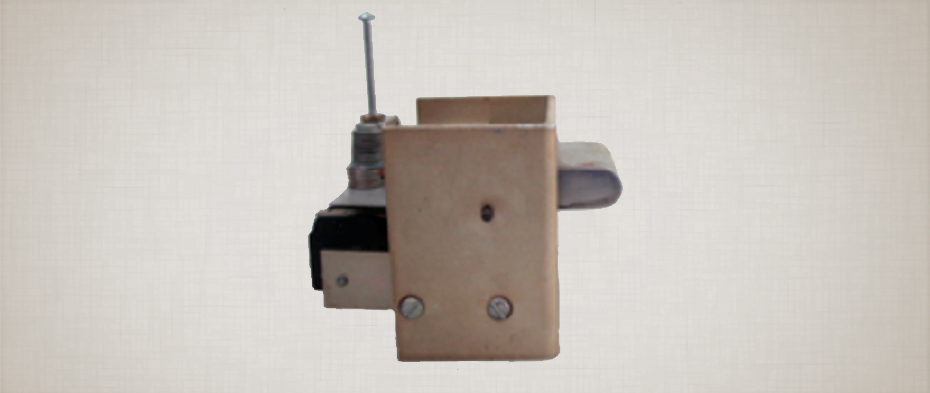 Very similar to the Ralph Gerbrands Company rat lever also in this display. The black object in the foreground at the left rear of the lever is the microswitch that activates when the lever is depressed.
Very similar to the Ralph Gerbrands Company rat lever also in this display. The black object in the foreground at the left rear of the lever is the microswitch that activates when the lever is depressed.
Rat Lever
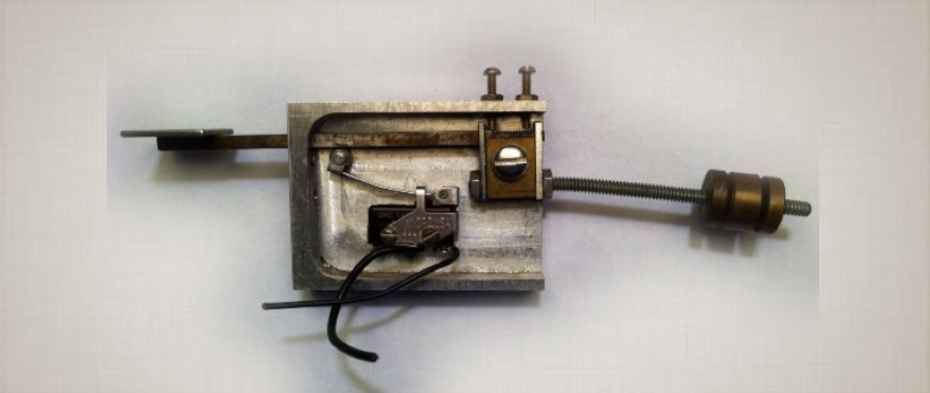 The lever – the left part of the device - protrudes 1.75 inches (3.6 cm) into the chamber. The screw on the right side of the device is a counterweight designed to allow rather precise specification of the force required to operate the lever. When the lever is depressed, it activates the small black microswitch in the middle of the device, thereby recording a response.
The lever – the left part of the device - protrudes 1.75 inches (3.6 cm) into the chamber. The screw on the right side of the device is a counterweight designed to allow rather precise specification of the force required to operate the lever. When the lever is depressed, it activates the small black microswitch in the middle of the device, thereby recording a response.
Retractable Rat Lever
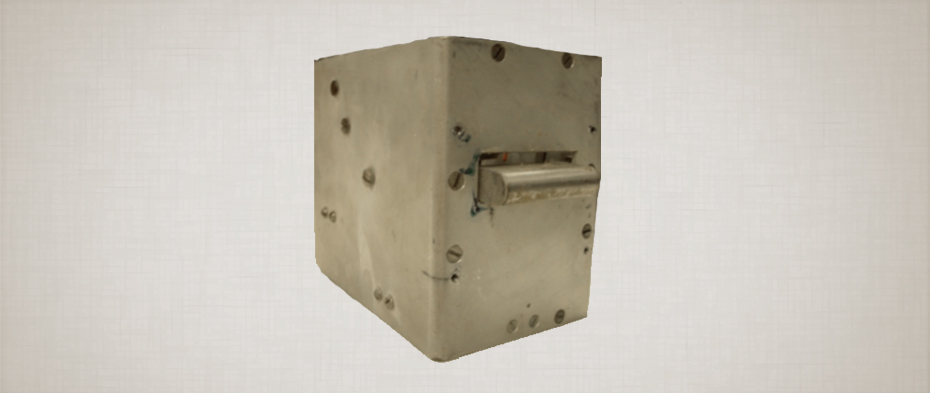 Consider a situation where two levers are available simultaneously, but each is active only when a pilot lamp above the lever is turned on. It is highly likely that a rat or, especially, a primate (including humans) will operate both levers even though only one is active (primates are notorious for pushing the two levers at the same time with their two hands). To prevent these inappropriate and unwanted responses on the inactive lever, a retractable lever was developed. The lever shown here can be retracted from and extended into the chamber by activating a motor with a device on it that shuts off automatically once the lever reaches its appropriate position. The lever is identical in size to the fixed-position levers manufactured by the Ralph Gerbrands and Scientific Prototype Companies, also on display in this room. The larger housing unit holds the motor used to extend and retract the lever.
Consider a situation where two levers are available simultaneously, but each is active only when a pilot lamp above the lever is turned on. It is highly likely that a rat or, especially, a primate (including humans) will operate both levers even though only one is active (primates are notorious for pushing the two levers at the same time with their two hands). To prevent these inappropriate and unwanted responses on the inactive lever, a retractable lever was developed. The lever shown here can be retracted from and extended into the chamber by activating a motor with a device on it that shuts off automatically once the lever reaches its appropriate position. The lever is identical in size to the fixed-position levers manufactured by the Ralph Gerbrands and Scientific Prototype Companies, also on display in this room. The larger housing unit holds the motor used to extend and retract the lever.


